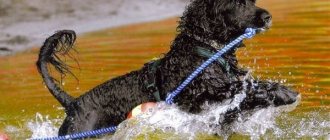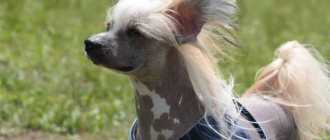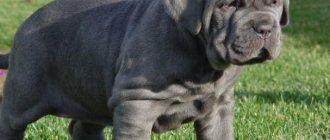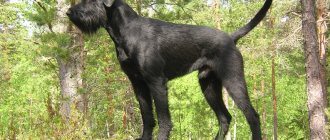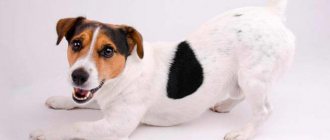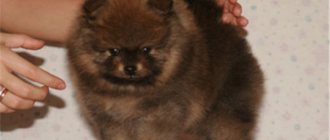Eurasier, or Eurasier (English Eurasier, or Eurasian dog, German eurasier) is a Spitz-type dog breed. It is a medium-sized dog with thick, medium-length fur that comes in a variety of colors.
The dog is self-confident, calm and balanced, he is devoted to the whole family, but is reserved towards strangers. He must live closely with his family as he is not suitable for being kept in an kennel or on a chain.
History of the Eurasian Spitz (Eurasier)
The Eurasier (Eurasian Spitz) is a breed developed in Germany.
Its “founders” are Julius Wipfel and Charlotte Baldamus. They were inspired by the description of a dog from Konrad Lorenz's book A Man Finds a Friend (1954). It tells the story of a dog who is incredibly loyal to his owner and easy to train. Outwardly, he looked like a cloud: he had long, airy hair, thanks to which he calmly endured severe frosts. Wipfel and Baldamus reasoned that the dog being described was similar to both a Wolfspitz and a Chow Chow. And it was representatives of these breeds that breeders began to cross in an effort to obtain puppies with the desired characteristics. In general, the offspring met the requirements, but were too short. Then Samoyed huskies were involved in crossing, which helped to get the dogs that we now call Eurasians.
Officially, these dogs are called Eurasiers, but other names of the breed are also found: Eurasian dog, Oirazier, Eurasian Spitz and Wolf Chow
In 1971, the first Eurasian Spitz nursery was opened. Official recognition soon came: in 1973, the breed was registered with the International Cynological Federation FCI. Eurasiers are described in FCI Standard No. 291 and are included in Group No. 5 “Spitz and primitive type breeds.” The Kennel Club recognized the breed in 2003.
History of the origin of the breed
The Eurasier was bred recently - in the second half of the 20th century, and is the youngest recognized breed in Germany. The work was carried out at Jägershof, a German nursery, by S. Baldamus, its owner, and J. Wipfel. At the start, offspring were obtained from Keeshond and Chow Chow; later Samoyed husky blood was added to the nascent breed, which gave the dogs some “northern” appearance features.
The scientist W. Schmidt noticed that the resulting dog’s character resembles the one described by the ethologist K. Lorenz in his books “The Ring of King Solomon” and “A Man Finds a Friend”: a good-natured, easily trained guard, a random cross between a German shepherd and a chow-chow. Professor Schmidt decides to participate in breeding work.
The breed has received recognition from the FCI and has its own club, founded at the same time it received the name “Eurasier” (Eurasian dog, Oyrasier) - in the 80s of the last century. Dogs are best known and most common in Europe.
Photo: wikimedia.org
Purpose and use of the Eurasier
The Eurasian dog was created by Julius Wipfel primarily as a creature with a sweet, easy-going character, as an easy-to-control companion dog, as a wonderful family pet and a universal family favorite. And in this, Professor Wipfel and his team succeeded. It is for the purpose of acquiring an easy-going and gentle furry friend, companion and pet that representatives of the Eurasian breed are most often adopted in modern Germany and some other European countries. It is also known that the “Eurasians” are very good and “ringing” watchmen. It is possible that they are also good hunters (after all, they have Samoyed huskies and Wolfspitzes in their blood), but the youth and relative rarity of the breed do not allow us to draw any final conclusions about the real talents and prospects of these dogs. All this is yet to come.
Choosing a nickname
You may like the already existing nickname: Dick, Ram, Charlie, Joy - for a male, Ray, Lexi, Mickey, Chau - for a female. You can take a closer look at the pet’s appearance or character and call it a completely new name: Bear, Fury, Fox. You can even give the dog the name of a literary or movie character: Chuya, Muba, June, Rega, Solo.
Photo: maxpixel.net
External features of Eurasians
The Eurasier is a robust, medium-sized dog. According to FCI standards, representatives of the breed must have the following external characteristics (any deviation will be grounds for rejection):
- Dog size: height at withers for males - 55-60 cm, for females - 48-56 cm. Weight of adult dogs - 23-32 kg.
- The head is moderately wide. The forehead is low and flat. The skin fold on it is clearly visible, which makes the dogs seem serious and even a little gloomy.
- The mouth is wide, only black edging of the lips is allowed.
- The jaw is rounded and strong. A pincer bite is allowed. The teeth are relatively small and wide.
- The ears are medium in size, shaped like a triangle with a rounded apex, and point clearly forward.
- The eyes are large, not very deep-set, but not protruding either.
- The body is strong, the back is long and straight. The withers are pronounced, the chest is wide. The abdomen is raised quite high.
- The tail is thick and carried high. When at rest, the dog holds it curled in a C-shape over its back.
- The limbs are tall, thick, with wide pads. Both the front and hind legs of a dog in a standing position should be parallel. The shoulders are equal to the forearms, and the hips are equal to the shins.
The “fur coat” of Eurasians is dense, with a thick undercoat. The shortest is on the muzzle, ears, shins and forearms. Tight “pants” form on the hips. A thick collar and long hair on the tail are required. Can be any color other than solid white.
Eurasians have a peculiarity: it is difficult to tell from the puppy exactly what color its fur will be later. The reason is that during the first shedding, the puppy's fur completely changes into adult fur, which can be a couple of shades lighter or darker.
Breed standard
Head:
- not very wide, shallow stop,
- the ears are vertical, triangular in shape with equal sides, set high,
- the muzzle is neat, wedge-shaped,
- lips, nose and eyes are dark, eyes with a “sweet” or intelligent expression, slanted.
Torso:
- stocky, not long, proportional,
- ring-shaped tail pressed to the body, thick, abundantly pubescent,
- paws are strong and muscular.
Wool:
- medium long, thick, soft to the touch,
- the undercoat is thick, raises the guard hairs,
- feathering on the front legs, “pants” on the hind legs,
- Acceptable colors: red (any shade) or black plain, tan with gray or black and zoned gray; brown and white animals are considered defective.
Photo: flickr.com We recommend reading: Everything about the Greater Swiss Mountain Dog breed: description, standards, maintenance features
Care
Like all dogs, they should be fed only high-quality food. They can be picky eaters and changing their diet will help them avoid becoming bored with one type of food.
They eat in a controlled manner, usually do not overeat, and take their food very delicately. Despite their pickiness, it is quite possible to accustom them to different types of food. But every dog has its own individual preferences.
As with all dogs, the breed's nutritional needs change from puppyhood to adulthood and will continue to change into adulthood. You should ask your veterinarian for recommendations regarding your pet's diet, as there are too many differences between individual dogs—including weight, energy, and health—to make a specific recommendation.
To keep them clean, they need to be thoroughly combed and brushed once a week or twice a week, checking their body for parasites.
You need to clean their eyes, ears and check their paw pads; and also occasionally trim their nails if necessary (especially their dewclaws). They have little body odor and require infrequent bathing. They typically shed all of their undercoat once or twice a year for about 3 weeks.
During periods of shedding the undercoat requires daily brushing/combing to minimize the number of “hairballs” in the home. If a dog is spayed or neutered, his coat may become much thicker, longer, and more difficult to manage.
Characteristics of Eurasians
Eurasiers are companion dogs. They are incredibly loyal to their owner, obedient, easily learn and follow commands, and rarely show aggression (only when their owner is in danger). These sociable animals are patient with children and easily get along with pets.
Eurasiers are too good-natured to offer serious resistance to robbers, so they should not be used for protection - after all, they are more of a companion dog than a stern watchman
Eurasiers are hardy. For example, if you take such a dog with you on a bike ride, it will easily run alongside you for a long time. But Eurasiers are not known for their playfulness: they can fetch balls and get through obstacles, but they will do this to please the owner, and not for their own pleasure.
Among the disadvantages of the character of Eurasians, it is worth noting that they are touchy, for example, if they are not paid attention to or are left alone at home for a long time
Eurasians will not bother a person, but constant attention and approval are important to them. They seem to expect that every 10-15 minutes the owner will address them with a kind word and praise them for good behavior. If you don’t do this, the dog will be offended. By the way, because of this same character trait, Eurasians should not be left alone in an enclosure or in the yard - they will think that they have been abandoned. Companion dogs should be kept inside the home where all family members live.
Eurasiers are fairly silent dogs, not very fond of barking or howling.
Characteristics of the evarzier
| Attachment level | Average |
| Friendliness | Average |
| Suitable for children | Yes |
| Loyalty to other pets | High |
| Exercise needs | Average |
| Playfulness | Average |
| Energy level | Average |
| Learning ability | High |
| Intelligence | High |
| Tendency to bark | Low |
| Shedding intensity | Low |
Exhibition standards
The breed has its own approved standards, compliance with which is a prerequisite for participation in exhibitions and breeding.
Head
- not wide, with a shallow stop;
- ears – set high, triangular, with equal sides, positioned vertically;
- wedge-shaped muzzle, neat;
- eyes, lips, nose - dark, the expression of the eyes is intelligent, slightly slanted.
Torso
- proportional, tightly knit, not long;
- the tail is ring-shaped, pressed to the body, abundantly pubescent, thick;
- limbs – with well-developed muscles, strong.
Wool
- medium length, thick, soft;
- undercoat – thick, guard hairs raised upward;
- the front legs have feathers, and the hind legs have “pants”;
- colors – red (any shade), monochromatic black, tan with gray or black, zoned gray.
Warning! The breed standard allows solid colors. The exception is white. If there are white spots on the coat, the dog is also disqualified.
Oirazier in the yard of the house
Tendencies towards pathologies
In general, Eurasiers are strong and healthy dogs. The average life expectancy is 14–16 years. In rare cases, the following congenital pathologies are possible:
- dysplasia of the hip and elbow joints;
- congenital prolapse of the kneecap;
- ectropion - eversion of the eyelid;
- hyperthyroidism is a disease of the thyroid gland in which an excess amount of thyroid hormones is produced.
It is important to take into account the predisposition of Eurasians to the listed diseases and have the purchased puppy checked for them by a veterinarian. If detected in a timely manner, all pathologies can be easily cured and do not pose a threat to the dog’s life, and are also not grounds for refusal to obtain FSI (breed conformity) documents.
Reasons for disqualification
If the owner has plans to participate in exhibitions and breed purebred offspring, then first he must obtain a certificate stating that the dog meets all the requirements for Eurasians. The commission may not provide such a document if serious deviations from breed standards are discovered. Reasons for disqualification are:
- drooping or semi-erect ears in an adult dog;
- too close-set, small eyes;
- flat muzzle;
- lack of a complete set of teeth (for example, canines, incisors, molars, etc.);
- severe malocclusion (underbite or overshot);
- sparse undercoat, curly coat;
- lack of pigmentation (light eyes, whitish lips, pink nose, solid white coat color).
Character can also be a basis for rejection: Eurasians should not show excessive aggression, be too cowardly, or nervous
How and what to feed
Many Eurasians are light eaters, and some are downright picky. Although they are not prone to overeating, it is recommended to feed moderate amounts twice a day rather than withholding food all the time (called free feeding).
Ask your breeder or veterinarian to recommend a good food for your Eurasier, as well as how much to feed.
pros
Wonderful family dog
The house is clean and calm
Easy to care for, low shedding coat
Minuses
Can't be left alone for long
Sensitive to family disturbances
Some people are picky eaters
Content Features
The Eurasier is suitable for living in an apartment if the owner is not afraid of the need to regularly brush the dog and take long walks. Free outdoor living is also suitable. Life in a closed enclosure or on a chain is strictly contraindicated for this good-natured, sociable creature.
The Eurasier is a very active, agile dog that requires good physical and mental stress. Can become a companion on a morning jog, on long hikes and active sports. Walking your dog should not be limited to running circles around the perimeter of the park. There must be the possibility of free running, games, exercises for ingenuity and search tasks.
Education and training
The Eurasier is smart and understanding, easy to train and loves activities with its owner. Sometimes he can be stubborn, a character trait he inherited from his Chow Chow ancestor. He doesn’t like to be bored, so the owner’s task is to make activities with the dog interesting and varied. The Eurasier does not tolerate rudeness , so use the method of positive reinforcement during training sessions.
Since the Eurasier is an active dog, any dog sport is suitable for him: agility, frisbee dog, freestyle, flyball, skier towing, and so on. In winter, the Eurasier will happily take small children for sledding rides.
Tips for caring for your Eurasier
This handsome guy is very sociable and sociable, and it is for this reason that he extremely does not like to be left alone or sit on a leash. He is quite active and loves long walks, and therefore walking these funny dogs should be quite long with the opportunity to actively run and play.
We recommend reading: Brachycephalic dog breeds - complete list
Keeping such a dog in regions with a hot climate is also problematic; the pet simply succumbs to the heat in its warm fur coat, becomes lethargic, drowsy, and can even get sick. Feels great in cool or even frosty climates.
The Eurasier's thick coat requires regular intensive care. If you don't want to fill your entire house with wool, you'll have to work hard. It is advisable to comb this pet as often as possible. And certainly no less than 2 times a week.
There are certain difficulties with bathing such a pet. And the point here is not at all that he does not like to swim. With this, everything is in order, Eurasians are very obedient and flexible, and they are not afraid of water. But it’s not so easy to rinse thick thick wool well. And it’s even more difficult to wipe it off from water and dry it later. Drying your dog is best done with a special hair dryer, while combing it. It is recommended to wash your furry pet only if absolutely necessary.
The diet for an energetic Spitz of Eurasian origin is quite comparable to that of a Wolfspitz or a medium-sized husky. And choosing it is not at all difficult, especially if you use special industrially produced food developed by nutritionists (preferably holistic class) for dogs of energetic breeds with a rich coat. This is exactly what pedantic and thrifty Germans do when they get this cute Spitz. The only thing you need to remember is that if your pet does not receive a full and long-term walk, then the dosage should be significantly reduced. Otherwise, the animal may become fat, losing its unique appearance and remarkable mobility.
Nutrition
The Eurasier is rarely picky about food unless he is pampered, and quickly gets used to the type of food offered. These can be natural products or ready-made dry food. In any case, the diet should be balanced and appropriate to the age, size and physical activity of the dog. Eurasians eat moderately and are not prone to overeating or being overweight.
It is important to remember the Eurasier’s predisposition to gastric volvulus and take all possible preventive measures to prevent the development of a dangerous pathological condition.
Character and temperament
Werner Schmidt wrote that he has never met more loyal dogs than the Eurasier. Indeed, this dog is ready to tirelessly follow a person, without leaving a single step from the owner. The Eurasier is a companion dog that is ready to protect its owner if necessary.
Pros:
- communicative;
- devoted;
- ready to guard;
- good-natured;
- funny;
- not aggressive;
- has a stable psyche.
Minuses:
- stubborn;
- loves noisy games;
- touchy;
- doesn't like to be alone;
- sensitive to punishment.
Eurasian health
Although the Eurasian dog is considered an animal with fairly good health and good immunity, it, like many artificially created breeds, has not avoided health problems inherited from the breed’s ancestors.
Breed predispositions that have been identified so far include the following: hip dysplasia, subluxations of the kneecaps, hypothyroidism (thyroid hormone deficiency), ectropion (eversion of the eyelid) and distichiasis (growth of additional eyelashes in places that cause irritation, chafing of the cornea of the eye, increased tearing). ). The development of urolithiasis is possible, especially in older animals. It is possible that further study of breed characteristics will add a few more points to this “bouquet”.
The stated average lifespan of Eurasian dogs is between 14 and 15 years, which causes some mistrust. Still, the dog is quite large and not without genetic problems.
Lifespan
The average life expectancy of the Eurasier is 12-14 years.
Diseases
Life expectancy is 14-15 years, but this data still needs to be tested by time. Health is good, as dogs have strong immunity to common canine contagious diseases. Of the non-infectious Eurasiers, they are predisposed to:
- urolithiasis (old individuals),
- epilepsy,
- subluxation of joints (dysplasia),
- hyperthyroidism,
- inversion of the eyelid, distichiasis.
Photo: wikimedia.org
Choosing a Eurasier puppy
It is definitely worth buying a puppy of a young breed from a nursery. If only because experienced breeders, being members of a parent or other breed club, subject all their dogs to health testing, they can guarantee that the producers and their offspring have the character traits that are expected of them.
A responsible breeder is always interested in placing puppies in good hands. He does not hide information about temperament, health and maintenance characteristics. He will definitely explain why he sells some puppies cheaper and others more expensive. Will help in choosing a puppy and support in the future.
It is impossible to predict which puppies in a litter will become champions. Those who are interested in a show and breeding career in the future should consider buying a juvenile or adult dog.
We recommend reading: Maine Coon weight by month - table, photos, real numbers
It is better to choose a puppy personally. Be sure to evaluate the conditions in which the dogs are kept and carefully inspect the litter. All babies should be well balanced, healthy in appearance, curious and friendly. Be sure to pay attention to compliance with the standard. Even at 2-3 months, a Eurasier puppy should largely correspond to the description drawn up for an adult dog. Puppies must be treated for parasites and vaccinated in accordance with their age, have a brand and documents of origin.
Price when buying a Eurasier puppy
It is still extremely difficult to buy a dog of this breed in Russia - it has not yet won the hearts of Russians, and the breed itself is still little known to a wide circle. Therefore, there are no Eurasian nurseries registered in Russia. Those few puppies that appear from time to time in the capital cities of Russia, as a rule, are brought by couriers to order from Germany. German nurseries are so far the best in this sense, especially in the city of Weinheim in Baden-Württemberg, where the breed was created.
How to choose a Eurasian dog puppy
The breed is not widespread and appears in nurseries in different countries with varying degrees of success. Breeding Eurasiers requires special effort, since the percentage of puppies that clearly meet the standard is low; There are several Eurasian nurseries on the territory of our country, so after waiting a little, you can get your treasured pet. The price of a promising puppy can reach $1000. If you are looking for an ordinary pet without pretensions to a show career, then you can choose any puppy that suits your taste. You should start from personal preferences regarding gender, coat color and character.
What to look for when choosing a puppy:
Documentation. Pedigree, as well as the successes, awards and status of the parents can say a lot about the prospects of the puppies from the litter. There is no need to hesitate to ask the breeder about the condition of the babies, their activity and potential. The breeder observes the animals daily and clearly sees the strengths and weaknesses of each puppy. Veterinary card. The animal must be vaccinated, and a vaccination mark must be placed on the veterinary card. By choosing an unvaccinated animal, the owner puts both himself and the puppy at risk. Compliance with breed standards. This point can be skipped by those who do not plan to make the dog a show star, but who want to become a full-fledged family member and best friend. Activity. No need to choose cowardly, aggressive, passive puppies
A suitable puppy will cuddle, climb into your arms, and try to attract all attention to itself. The choice should be made on the most active and friendly puppy from the litter. Health
Puppies must be clean, well-groomed, and moderately well-fed. The eyes and ears should not have any discharge. The movements of a healthy baby are free and relaxed, the coat is shiny and soft.
Advantages and disadvantages
One of the advantages of dogs of this breed is that they can be kept both in a country house and in a city apartment. However, when planning to have this cheerful and active creature in a city apartment, the potential owner must take into account that the dog will require regular and long walks. Being a very energetic animal by nature, the Eurasian will need not only walking, but also games and communication. However, an indomitable temperament is not typical for them, so physical activity among Eurasians should be relatively moderate.
Eurasians are easy to learn and quickly remember new commands. Dog handlers claim that even an inexperienced breeder can handle their training. Dogs of this breed are perfect for canine sports - agility, obedience. These features of Eurasians suggest an appropriate approach to animals on the part of their owners. A person planning to get a dog of this breed must understand that his pet will require attention, communication, and movement.
Another undeniable advantage of Eurasians is their goodwill and non-conflict nature. They easily find a common language with children, which allows them to fearlessly keep dogs of this breed in large families with children.
The natural lack of aggression towards strangers does not allow the use of Eurasiers as guard dogs. However, if this dog senses danger threatening its owner, it may show its protective qualities.
Some breeders consider the need for careful care of the dog's hair to be a disadvantage of keeping Eurasians. The coat of these dogs requires regular brushing and washing, without which the dog quickly takes on an unpresentable appearance.
A separate disadvantage is that Eurasiers are considered a rather rare breed of dog. Outside of Europe, animals of this breed are rarely found. For this reason, purchasing a Eurasier puppy may involve certain risks. Thus, some unscrupulous sellers often sell puppies of more popular breeds (Wolfspitz, Samoyed husky mixes) under the guise of Eurasiers. Inexperienced buyers, poorly informed about the standards and rarity of this breed, may not suspect fraud when making such a transaction.
The rarity of the breed also determines the rather high price of puppies. Eurasian babies cannot be suspiciously cheap, so you should pay special attention to this nuance when purchasing an animal.
Photo
Photo: wikimedia.org
Photo: wikimedia.org
Photo: pixabay.com
Photo: wikimedia.org
Photo: wikimedia.org
Photo: pixabay.com
Did you like our article? Write what you think about this wonderful breed of dog in the comments, we will be happy to discuss.
Photos
The gallery contains photos of puppies and adult dogs of the Eurasier breed (Eurasian dog, Oyrasier).
Feeding
Follow general rules for feeding dogs. It is especially important to ensure that puppies are properly fed. The pet's diet is, first of all, proteins (50%), also carbohydrates, fats and minerals: lean meats, sinews and cartilage as treats, cottage cheese, boneless sea fish, kefir, walnuts, buckwheat and oatmeal, raw vegetables and fruits. An adult dog is fed twice a day.
Watch a short video of a Eurasier eating ice cream, but in this article we explained why you need to be very careful about it.
Interesting facts
Eurasier is very successful in dog sports - freestyle, frisbee, flyball games, agility, etc. In winter, he can take children on sleds.
There is no national breed club in Russia, so to buy a puppy you need to go to Europe. It costs about one hundred thousand rubles (as of the beginning of 2022)
Sources
- https://prohvost.club/sobaki/porody-sobak/evrazier-poroda-sobak.html
- https://tutknow.ru/animals/6402-opisanie-porody-evrazier.html
- https://PetGuru.ru/porody/evrazier
- https://zoofanat.ru/sobaki/porody-sobak/shpicy/evrazier.html
- https://usatiki.ru/evrazier/
- https://vplate.ru/sobaki/evraziery/
- https://www.pitomec.ru/kinds/main/dogs/dekorativnye/eurasier
[collapse]
Character
The Eurasier is a very cheerful dog, happy when young, even if it becomes more aloof as it gets older. Despite this, he remains sociable towards people and other animals. He is quite independent, but remains close to his people and his social group without necessarily being a glue pot. He is an intelligent dog and, although quite playful, remains fairly calm and collected as long as his physical and mental needs are met. With strangers he may show some distance
It is important to teach him to feel loneliness in a positive way and to progress as early as possible, in which case he may not accept it. He is cautious and barks little or nothing unless he considers it necessary.
He can live perfectly well in an apartment or house, provided that he is spent physically (the garden is not a place for walks!) and mentally, every day.
Appearance of a Canaan dog
General impression
As you can see in the photo, the Canaan dog is similar in appearance to a large Spitz. The beauty of the animals is laconic and simple, everything in their appearance is carefully thought out and organic - a practical fur coat and a classic silhouette, reminiscent of the fact that the ancestors of the animals were wolves.
Head
Strong, well-proportioned, with a flat forehead, the size of the Canaan dog is medium. The transition to the muzzle is smooth and not clearly expressed. The muzzle itself is quite wide, the jaws are well developed, the teeth are white, dense and not large, forming a correct bite.
The nose is mobile and black. The eyes are almond-shaped, with an intelligent and expressive look. The iris is dark brown or brown in color. The ears are raised, set wide apart, tapering from the base to a rounded tip.
Torso
Knocked down, muscular, body – square format. The chest is deep, clearly defined, and medium in width. The line of the back is straight, shortened, the loin is convex. The groin is tightened.
Front and hind limbs
Elongated, oval, medium in thickness. The hind legs, with well-developed muscles, are set wider than the front legs. The hock joints are flexible and set high. The hands are round, the fingers are strong and grouped, the claws are dark and strong.
Wool
The Palestinian Shepherd has a double coat; despite this, the dog easily tolerates high humidity and heat. The guard hair is hard and long, and comes in different lengths. Dogs with semi-long hair have contrasts in the length of the guard hairs in the head, limbs, and body.
The neck of purebred animals is decorated with a “collar”. In short-haired dogs, it is formed on the chest by elongated hair. The density of the undercoat is determined by the dog's climatic conditions.
Canaan dog colors
The color of the Bedouin Shepherd includes white, black, brick-brown, sand, cream, gold, and red. White markings are allowed. Tricolor, grey, dark tan or brindle coat colors are excluded.
Size
The height of the Canaan dog at the withers is 52-62 centimeters, while males are slightly larger than females. The weight of the Canaan dog reaches 22 kg in adulthood for females and 26 kilograms for males.
